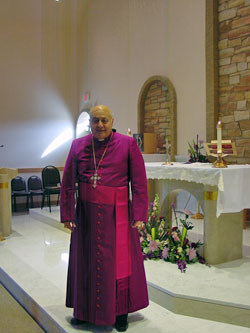As the ceremony got under way for the new $3.5 million facility on 2.3 acres on Grace Street, three selected members of the clergy, “older, middle and younger” remained inside, while the rest assembled at the front door. Those inside represented the three generations of the church—the Adamic, the Old Testament and the New Testament.
Portions of the ceremony were unique to the Eastern rite church, which dates back to apostolic times in the Middle East; yet, many of the practices mirrored those exercised in Latin rite churches as well. The overflow crowd watched enthusiastically as Bishop Shaheen used holy oil and made the sign of the cross on the door. As the gathering of faithful processed into the church, which regularly seats 300, the choir sang hymns in their native tongue. In this solemn religious ritual, Bishop Shaheen offered an opening prayer and sought God’s blessing. During the prayer of forgiveness, incense was burned and selected readings were recited. Following a reading of the Gospel, clergymen incensed the Book of Gospels, and Bishop Shaheen offered the homily based on the readings and the liturgy. He expressed his gratitude to the pastor and the congregation for their dedication and commitment to a project that was two and a half years in the making.
After the Nicene Creed, the bishop led a processional around the church, using oil to anoint the main door, making the sign of the cross and sprinkling water on the walls as a way to consecrate the inside of the 10,000-square-foot edifice, which is complemented with several classrooms and a banquet facility large enough to accommodate 250 people. The lilting voices of the choir echoed and the congregation bowed their heads when the bishop initiated the consecration of the altar. A ritual that included pouring chrism oil on the marble altar and blessing it three times in the name of the Father, the Son and the Holy Spirit, concluded once a white linen altar cloth adorned with a symbol of the Eucharist was spread and topped with altar candles and several gold chalices. The Eucharist was then celebrated for the first time on the newly consecrated altar.
One parishioner, Abdo Asmar, said he looked forward to having events at his own church. “I think it’s really, really a very special day in our community.” For Asmar, his wife and daughter, the opportunity to preserve their cultural identity as it is realized within the church is a matter he holds dear to his heart. “Our Mass has its own faith traditions. It’s a little different.”
A member of the congregation for the past 15 years, Anita Zodo of Chicago said the church is a link to her homeland in Lebanon. “It’s very important, especially when you’re not in your home country. You feel well connected here.”
After having assisted with spreading the special altar cloth, longtime parishioner Helen Shaker said the occasion was well worth the wait. “I feel wonderful. This is a big event for us. We’re very happy to have our church.”
A resident of the United States since 1983, Raymond Daou has claimed membership at the church for 12 years. He served as chairman of the steering committee that promoted the church-building project. With the construction of the new church completed, Daou said congregants would have more opportunities to celebrate not only liturgical events but also occasions that have particular significance to the congregation. Specifically, he said, the parish is planning a celebration of Lebanese Independent Day, which marks the day in which their homeland was liberated from Turkish rule in 1943. The parish is expected to sponsor the annual American-Lebanese Day.
In the celebration after the opening Mass, Bishop Shaheen walked briskly to the altar, stopping along the way to congratulate parishioners and clergy on their commitment. “I want to compliment the parish community and those who worked in an exceptional fashion. We’re blessed to have a Maronite church in this city of Lombard,” he said.
From an onlooker’s position, Bishop Schlarman commented about the traditions practiced in the Maronite tradition. “It’s a lot of older liturgy than our Roman rite, and it’s beautiful,” he said.
 By ANN PIASECKI, LOMBARD
By ANN PIASECKI, LOMBARD


